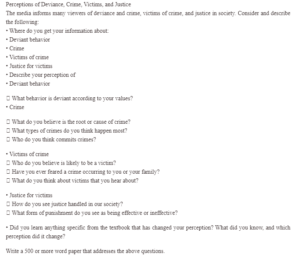Perceptions of Deviance, Crime, Victims, and Justice
With the current technological advancements, one can access information from various sources, including online blogs, articles, and websites. Accordingly, the media informs many viewers about deviance, crime, victims, and justice. However, my perceptions of deviance, crime, victims, and justice for victims stem from published research done by credible sociologists, psychologists, and other related specialists in this field of study.
We offer assignment help with high professionalism.
Deviance
Deviance is a behavior, trait, or belief that violates social norms. For instance, alcoholism (behavior), different skin color (trait), and other religions (faith) can be described as deviant. Additionally, perceptions of deviance change over time. For instance, it was deviant for women to wear trousers in ancient years. This perception has changed as women wear trousers and are not seen as evil. Deviance also varies across various communities (Benokraitis, 2019). This difference is attributed to the differences in social norms across distinct communities. What is considered deviance in one neighborhood might be socially acceptable in another. As a 21st individual, my behavior and values are shaped by social institutions surrounding me: family, school, and church. Therefore, deviant behavior for an individual like myself includes not engaging in family activities (like eating dinner as a family), skipping classes, and mistreating people.
Crime
Crime is violating legally enacted laws. It results from deviant behavior; therefore, deviance is the root of corruption. Accordingly, the symbolic interactionist theory is relevant in elaborating this perspective. It stipulates that people are socially constructed and explains that people learn behavior from other significant individuals such as parents and friends. Subsequently, if individuals’ criminal interactions exceed non-criminal interactions, they are likely to engage in criminal behavior (Cassella, 2020). Lastly, deviance leads to labeling and stigmatizing individuals, who are likely to develop a negative self-concept and engage in offending behavior. Therefore, crime is often committed by deviant people. Crimes that occur the most are victimless. These crimes have no direct victims because the involved individuals do not report the offenses or consider themselves victims. These crimes include illegal prostitution, drug use, and gambling (Benokraitis, 2019).
Victims of Crime
Chances of men and women being victims of crimes differ depending on the type of crime. For example, men experience higher homicide, aggravated assault, and robbery levels, while women experience higher rates of rape, intimate partner violence, and sexual assault. Similarly, violent victimization rates are higher for blacks, American Indians, and Asians than whites. Persons under 25 experience higher victimization rates than those aged 65 and above. The low-income earners are likely to be victimized approximately four times more than high-income earners (Benokraitis, 2019). As an African American, sometimes I am fearful that a violent crime might occur to my family since blacks generally have higher chances of being victims of violent crimes.
Justice
Crime is punished through formal sanctions like the criminal justice system. Punishment involves sentencing, incarceration, or capital punishment. A judge or jury imposes a sentence after finding an individual guilty of committing a crime. A sentence can be a fine, probation, imprisonment, or capital punishment. However, offenders on parole can be released before they complete their sentence if they obey the law and regularly check in with an officer (Benokraitis, 2019). Conversely, incarceration is the imprisonment of an offender, while capital punishment is the death penalty. The death penalty is the most ineffective form because it does not deter crime, the public support for capital punishment has waned, homicide cases have reduced rapidly since 1980, many false convictions have been overturned, juries can impose life imprisonment sentences without the possibility of parole, and African Americans are incredibly likely to be executed, especially if the victim is white, yet the vice versa is untrue.
Conclusion
Benokraitis’s (2019) textbook has provided insightful information about deviance (violation of social norms), crime, victims, and justice. One of the pieces of information learned is that not all deviant behavior is criminal. Even so, crime results from deviance. Additionally, social norms vary in different communities, and so does deviance. Accordingly, this has changed my perception of deviance and how I view people from other communities. For example, persons who did not spend time with their families appeared deviant to me. Conversely, knowing that people uphold different norms, I wouldn’t now view these people as being abnormal.
References
Benokraitis, N. (2019). SOC 6. Cengage Learning, Inc.
Cassella, K. (2020). Social Work and Deviant Behavior. Eastern Gateway Community College.
ORDER A PLAGIARISM-FREE PAPER HERE
We’ll write everything from scratch
Question

Perceptions of Deviance, Crime, Victims, and Justice
Perceptions of Deviance, Crime, Victims, and Justice
The media informs many viewers of deviance and crime, victims of crime, and justice in society. Consider and describe the following:
• Where do you get your information about:
• Deviant behavior
• Crime
• Victims of crime
• Justice for victims
• Describe your perception of
• Deviant behavior
What behavior is deviant according to your values?
• Crime
What do you believe is the root or cause of crime?
What types of crimes do you think happen most?
Who do you think commits crimes?
• Victims of crime
Who do you believe is likely to be a victim?
Have you ever feared a crime occurring to you or your family?
What do you think about victims that you hear about?
• Justice for victims
How do you see justice handled in our society?
What form of punishment do you see as being effective or ineffective?
• Did you learn anything specific from the textbook that has changed your perception? What did you know, and which perception did it change?
Write a 500 or more word paper that addresses the above questions.

